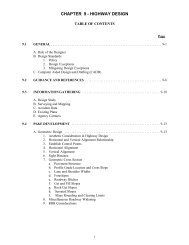Baltimore-Washington Parkway Widening Feasibility Study
Baltimore-Washington Parkway Widening Feasibility Study
Baltimore-Washington Parkway Widening Feasibility Study
- No tags were found...
You also want an ePaper? Increase the reach of your titles
YUMPU automatically turns print PDFs into web optimized ePapers that Google loves.
<strong>Baltimore</strong>-<strong>Washington</strong> <strong>Parkway</strong> <strong>Widening</strong> <strong>Feasibility</strong> <strong>Study</strong>ConclusionsThus, a widened B-W <strong>Parkway</strong>, whether inside or outside, will be able to carry more traffic but notnecessarily be less congested. More vehicles can move through the corridor if it is widened, but willlikely operate at similar levels of congestion as observed today.9.4<strong>Feasibility</strong>Criteria#4PreliminaryCapitalCostEstimatesThe preliminary capital cost estimate based on the Maryland SHA 2011 Highway Construction CostEstimating Manual ranged from $333 million to $537 million exclusive of operations and maintenancecosts. These cost estimates do not include any additional right-of-way acquisition costs. Based on theseinitial capital cost calculations, the outside widening options will cost more than the inside wideningoptions. The AASHTO widening options will cost more than the NPS widening options. The difference incost is due mostly to the wider shoulder impacts resulting from the AASHTO standards in comparison tothe NPS standards. This impact would affect both northbound and southbound widening options.9.5<strong>Feasibility</strong>Criteria#5PublicandPoliticalConsiderationsThere were strong concerns voiced by the stakeholders regarding the congestion on the B-W <strong>Parkway</strong>.Also of major concern to the public was maintaining the character of the <strong>Parkway</strong> for the historic,aesthetic, and natural values embodied in the National Park. The limited focus of the feasibility studywas very troubling to public and TAC participants alike. <strong>Widening</strong> without considering other modaloptions or managed lanes seems to result in feasible options that handle more traffic but do little torelieve congestion. That feeds into the concern that widening, at such a significant cost, seems to resultmore in negative impacts to safety, environment, noise level, and aesthetics than to the purpose ofmoving more people in a more efficient fashion.9.6<strong>Feasibility</strong>Criteria#6OwnershipandManagementThe implications associated with adding a third lane in each direction to the B-W <strong>Parkway</strong> may affect theability of the NPS to operate and maintain the corridor within its current legislated mandate. Thus, animpairments analysis would need to be conducted by the NPS. If a determination of impairment ismade, this would prevent the NPS from implementing any widening proposals. If the National ParkService was directed to move forward, then a federally legislated transfer of ownership andmanagement of the NPS section of the <strong>Parkway</strong> would need to be pursued. Currently, the NPS does nothave an agreement in place with any state or federal agency other than the District of Columbia thatwould dictate the process by which a transfer, or an exchange, of park land would be undertaken. Therewould thus be additional time needed for the development of such an agreement. Congressionaloversight may not be needed for the actual transfer but may be needed to remove the B-W <strong>Parkway</strong>from the National Park System. As such, this effort would involve planning and development from theDirector of the National Park Service and the Secretary of Interior prior to any discussion of transfer orexchange of this magnitude. However, considering the short-term and long-term costs of widening the73 November 2012
















